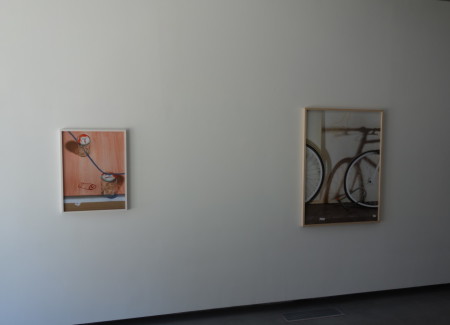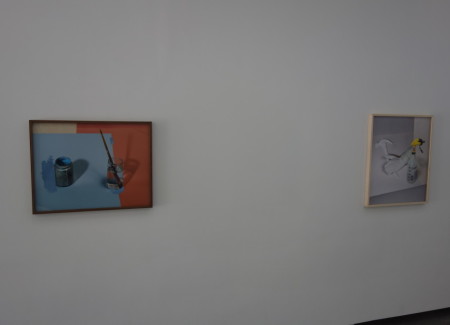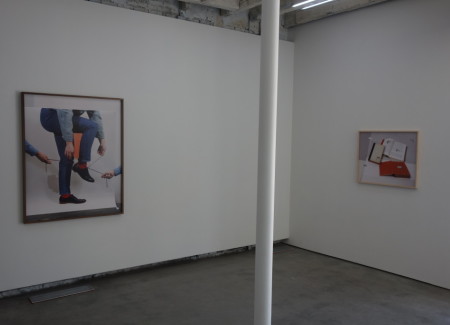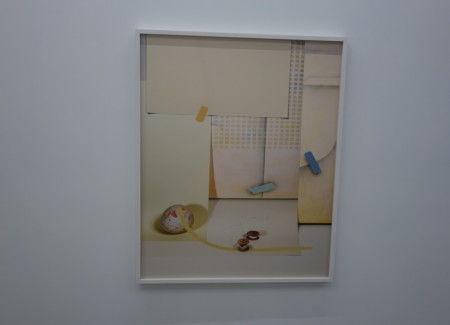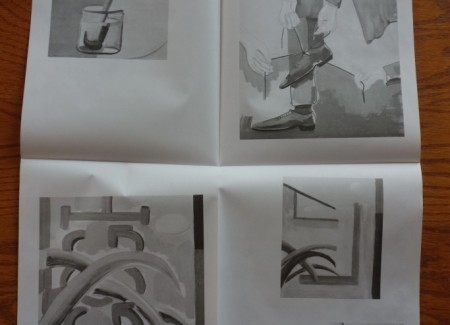JTF (just the facts): A total of 12 color photographs, variously framed and unmatted, and hung against white walls in the two room gallery space. All of the works are archival pigment prints (some with flashe paint), made in 2015 or 2016. Physical sizes range from roughly 29×22 to 54×43 (or reverse), and the prints are either unique or available in editions of 2+1AP. A printed newspaper has been published to coincide with the exhibit and is available from the gallery for free. (Installation shots below.)
Comments/Context: We’re going through a period of time in contemporary photography when curators and critics alike are annoyingly careful about stepping out into the light and declaring that certain early career artists are important. It’s a time when both everyone and no one is worthy of our attention – in analyzing younger photographers, as a group, we are inclusively nice and not yet entirely comfortable in choosing winners, often leading to a bland muddle of friendliness offered without much in the way of incisive judgment. Our museums are particularly guilty of this wariness these days, and the longer they stay on the sidelines, the more they lose their credibility as arbiters of what we should be paying attention to as the medium evolves. Actively designating a photographer as going somewhere is risky, but risks are what separate leaders from followers.
With that situation in mind, I’d like to make an unambiguous statement of my point of view as a collector/critic – John Houck’s newest show makes a compelling case that he belongs on the short list of young photographers worth following.
For the past several years, Houck has been meticulously unpacking and redefining the nature of rephotography, extending it far beyond the simple iteration and multiplication that had been its usual terrain. In his Aggregates series, he mixed the mechanistic rigor of digital arrays of color with the physicality of real folds, creating layers of bends and creases that smartly confuse our notions of two and three dimensionality – with the benefit of a tiny bit of hindsight, I expect these works will end up being cornerstone pieces from the early digital age of photography.
In his follow up History of Graph Paper series, he took rephotography somewhere else, engaging objects of personal significance in dances of revision, where the definition of space becomes uncertain, shadows are cast in contradictory directions, and objects multiply like ghosts and doppelgangers. These pictures seem to unmoor the laws of time itself, living in a quantum reality where still life subjects routinely inhabit two places at the same moment.
Houck’s newest works pick up from that deliberate visual uncertainty and introduce an element of playful gesturality into the artistic equation. Overpainting photographs is of course nothing new, but Houck interweaves his painting into his layers of rephotography, reveling in the contrasts of detail between photographic fidelity and loose impressionistic mark-making. His pictures still explore the disorienting reordering of physical reality, but now with an added element of obvious deception that we cannot possibly mistake for the representation of “photographic truth” – painted coffee fills an actual cup, painted tape holds up real sheets of paper, painted cutouts interrupt books, and painted shadows fall behind actual jars and bottles. There’s even an image of bicycle wheels and their cast shadows, with one wheel protected by a painted lock and a drawn hand holding the handlebar shadow – photographic and painterly surfaces have been seamlessly intermingled, in ways that don’t resolve. His pictures have a visual cleverness that is contagious, the conceptual simplicity of a painted line that defies logical spatial boundaries keeping us on our toes.
Other works introduce cast versions of the artist’s hands and overpainted grids of floating squares, adding additional compositional elements that arrange space or distort its now-broken rules. While Houck’s previous series felt weighted with psychological meaning and personal resonance, these pictures are lighter and more joyful in their illusions and games – tying a shoe with too many hands and a painted lace recalls the cerebral wittiness of 1970s photoconceptualism. And one image with overpainted cut forms interrupting a marble statue feels like yet another angle opening up to be explored, the physical depth of the forms creating a thickness of space that can, of course, be undermined.
Drawing on his experience as a software engineer, Houck’s photographs seems to be built on nested loops, with recursion, iteration, and progression all in constant use – it’s almost as if these pictures can be reduced to hidden algorithms, where serial steps, additions and aggregations lead to rephotographed layers that continue to build on themselves. That kind of logic feels new to photography, and it is leading Houck to pictures that are increasingly complex and original.
Executing three solid bodies of work in a row shows that Houck is consistently driving his photography forward, each project building on the last but introducing new elements that are accelerating his momentum. It’s time for some museum to give him a small “first look” solo show – provide long reach historical context with Robert Cumming, Zeke Berman, and early William Wegman if you must, but give Houck credit for reinvigorating rephotography and extending in exciting new directions.
Collector’s POV: The prints in this show are priced at either $12000 or $15000 based on size. Houck’s work has little secondary market history at this point, so gallery retail remains the best option or those collectors interested in following up.
